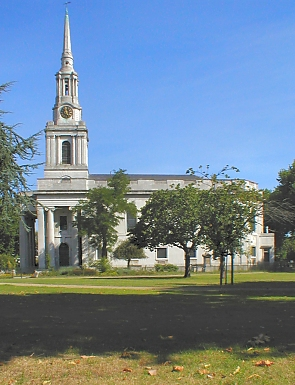All Saints
All Saints, Tower Hamlets
Poplar’s parish church and the Docklands Light Railway station named after it are both situated on the south side of East India Dock Road

The first religious institution in the district was Poplar Chapel, built by the East India Company as a chapelry of Stepney. In 1817 Poplar became a parish, with All Saints consecrated as its parish church in 1823. It was one of very few works by the architect Charles Hollis, who won the vestry committee’s design competition under the pseudonym ‘Felix’. The concealment of his identity did not prevent accusations of favouritism as he had previously been a clerk to a prominent parishioner, and the West India Dock Company complained, in vain, to the bishop. Built in Greek style from Portland stone, the church stands on Bazely Street, originally Bow Lane. Hollis was also responsible for the rectory.
All Saints’ churchyard was closed for burials in 1862 and was then progressively opened up to the public as a recreation ground and gardens. Immediately after the construction of the church, quality housing began to appear around it, prompted by the growth of London’s docks and the creation of the East India Dock Road.
Although a few 19th-century houses survive, many others were damaged by bombing during the Second World War and demolished afterwards. The council tower blocks that replaced them in the 1950s and 1960s dominate much of the area.
All Saints DLR station occupies the site of the North London Railway’s Poplar station, which operated from 1866 to 1945.
